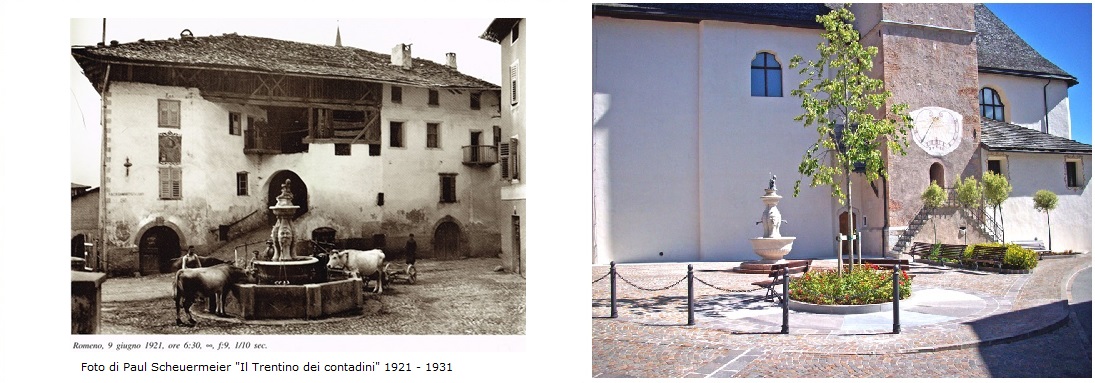In 1882 Romeno began construction of a new aqueduct under the direction of job site manager, Romedio Rodegher, a well known professional engineer born in Bresino and living in Cles . In those days there were very few homes with running water and most families had to take water from public fountains.
As a result of this hardship, engineer Rodegher on December 1, 1882 sent a personal letter to the local municipality asking them “to decide as soon as possible the location where a new fountain is to be built, in order to lay out the project and, once approved, build it”.Engineer Rodegher suggests the Crucifix Square, today Lampi’s Square, as the ideal location for the aqueduct, and recommends the municipality buy the nearby kitchen-garden owned by the Lanzerotti Brothers. The recommendation is accepted and Engineer Rodegher finishes the planning stage within the same month of December. For his work he was paid 51 Flourins (1). Cesare Scotoni, of Trento finishes the construction of the fountain by mid 1883 and is paid 700 Flourins. The small bronze sculpture of the baby with fish, quite likely was obtained from another demolished fountain. The sculpture was provided by engineer Rodegher, at a cost of 84 Flourins. The nickname “Rodeghin” is believed to be from the misspelling of engineer Rodegher’s last name.Luigi Zucal and Giuseppe Rosatti, both teamsters, known locally as ciaradori (2), carried the fountain from S. Michele to Romeno. Zucal was paid 79 Flourins and Rosatti 6.36 Flourins.In those months the construction of the fountain was halted and not placed where it was selected, and was stored inside the somas (3) of Beniamino Graiff.The aqueduct was completed by mid 1885 as water began gushing out of its four decorative faucets, thus becoming a vital source of water for many families in town. In 1935 a new aqueduct was constructed and the old fountain became an ornamental centerpiece.In 1956 during repaving work on streets and squares in Romeno, the Rodeghin fountain was removed from Lampi’s Square and temporarily set in the Townhall Square. Eventually its final destination was at the back of the church, replacing the existing wash-house.All residents of Romeno love this fountain and recall its years of service of providing water for so many years.
by Isidoro Tell
- The Flourin or Gulden were currencies valid during the Austrian-Hungarian Empire, between 1754 and 1892 . The Gulden was marked in German on Austrian Banknotes , while Flourin was used on Hungarian coins and banknotes.
- Ciarador means Teamsters in local slang
- Somas in local slang refers to the fireproof floor built with sand and lime inside every rural house.

 Italiano
Italiano Deutsch
Deutsch Español
Español